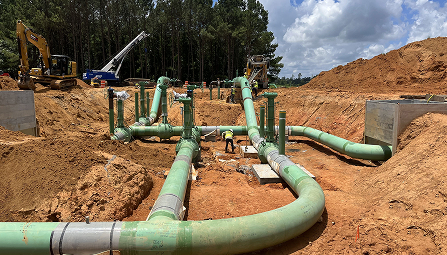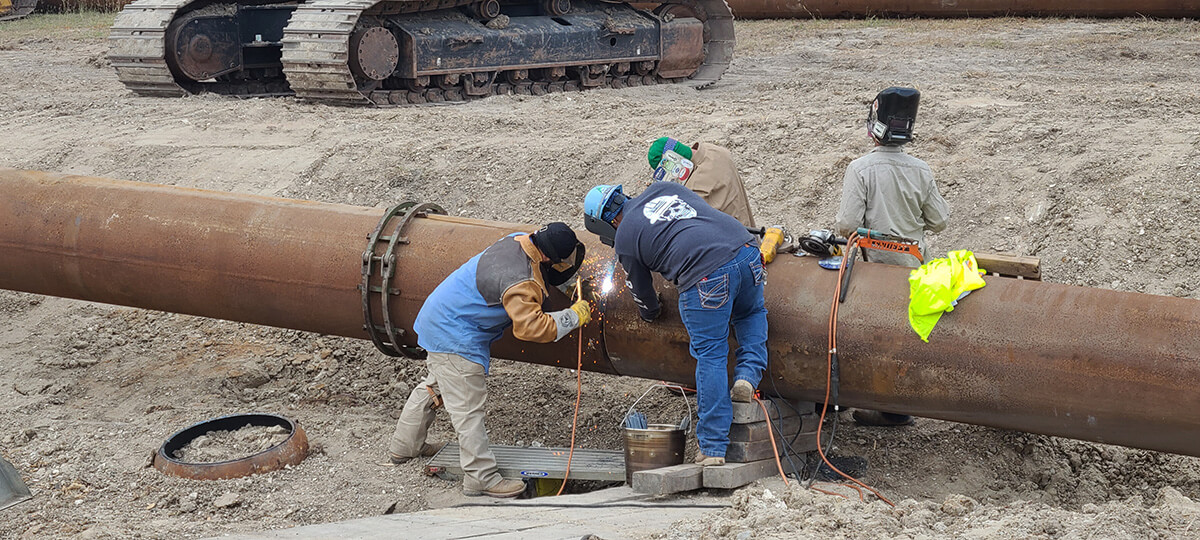10 Key Factors to Consider When Hiring Pipeline Construction Services
Wiki Article
Discovering the Newest Developments in Pipeline Construction Solutions for Modern Projects
The Pipeline Construction industry is undergoing considerable changes. Advancements such as wise materials and robotics are improving typical practices. These developments assure to improve effectiveness and safety and security. In addition, AI modern technologies are improving task management capacities. As these aspects assemble, they increase concerns about their long-lasting influence on sustainability and cost. Recognizing these technologies is vital for stakeholders seeking to navigate this progressing landscape. What effects do they hold for future jobs?The Rise of Smart Materials in Pipeline Construction
As the need for much more sustainable and efficient Pipeline systems raises, the integration of wise materials has become a transformative service in Pipeline Construction. These advanced materials possess distinct properties that boost the efficiency and durability of pipes. Self-healing polymers can instantly repair minor leakages, greatly decreasing upkeep expenses and downtime. Furthermore, materials embedded with sensing units can monitor architectural honesty and environmental conditions, permitting real-time data collection and evaluation.In addition, clever materials are corrosion-resistant and commonly lightweight, which not just simplifies setup but likewise extends the life expectancy of the systems. Their versatility makes it possible for pipes to withstand extreme ecological conditions, promoting safety and integrity. As industries significantly focus on sustainability, making use of environmentally friendly wise products contributes to reduced environmental effect. Overall, the increase of clever materials notes a remarkable shift in Pipeline Construction, leading the method for ingenious remedies to fulfill contemporary framework needs.
Innovations in Robotics for Setup and Maintenance
The combination of smart products in Pipeline Construction is enhanced by innovations in robotics, which are changing installation and maintenance processes. Robotic innovations, such as automated welding systems and drones, boost performance and precision, decreasing human mistake and decreasing safety and security threats. These robotics can operate in challenging environments, making certain that setups are conducted in remote or harmful areas without placing workers in danger.Robot examination tools outfitted with sophisticated sensors supply real-time information on Pipeline stability, enabling for aggressive maintenance. They can detect leaks or structural weak points, enabling prompt interventions that prolong the life-span of Pipeline systems. Using robotics not only accelerates the Construction timeline but also maximizes source allocation, bring about set you back savings. As these technologies remain to progress, they are set to play an essential duty fit the future of Pipeline Construction, making sure dependability and sustainability in framework growth.
AI-Driven Project Monitoring Devices Transforming Operations
AI-driven project administration devices are improving workflows in Pipeline Construction by enhancing decision-making processes through better accessibility to real-time data analytics. These devices enable groups to react promptly to task growths, thus increasing performance. Moreover, structured communication channels foster partnership amongst stakeholders, even more enhancing job end results.Enhanced Decision-Making Processes

Real-Time Information Analytics
Harnessing real-time information analytics, modern task monitoring devices change process in Pipeline Construction. These sophisticated tools utilize fabricated intelligence to provide instantaneous understandings right into task efficiency, source allocation, and potential dangers. By continually checking essential efficiency indications, teams can promptly adjust to altering problems, optimizing labor and products use. The assimilation of real-time information enables even more enlightened decision-making, lowering hold-ups and reducing prices. Furthermore, predictive analytics can identify trends and forecast difficulties prior to they rise, improving overall job performance. Therefore, Pipeline Construction business that adopt these AI-driven devices can improve job timelines and end results, ensuring they stay affordable in an increasingly complex industry landscape. This innovation marks a considerable change toward data-centric management methods.Streamlined Interaction Channels
Efficient interaction is paramount in Pipeline Construction, where various stakeholders have to team up seamlessly to assure task success. The introduction of AI-driven task monitoring tools has transformed communication networks within the sector. These devices assist in real-time details sharing, enabling groups to access updates, share files, and track development effectively. By automating routine tasks and offering a centralized system for communication, these developments eliminate misunderstandings and decrease hold-ups. Enhanced visibility into job timelines and resource allocation cultivates responsibility among staff member. Additionally, AI analytics can identify possible communication spaces, making certain proactive analytic. Eventually, structured interaction channels not just boost workflow however additionally elevate total task performance, enabling Pipeline Construction companies to fulfill modern needs properly.Enhanced Safety And Security Methods Through Innovation Combination
The combination of innovation in Pipeline Construction has resulted in enhanced safety and security procedures. Real-time monitoring systems, wearable security gadgets, and automated risk evaluations are currently essential elements in minimizing risks on work sites. These developments not only improve employee safety and security but also enhance conformity with sector guidelines.Real-Time Monitoring Solutions
Just how can real-time monitoring systems transform Pipeline Construction safety and security procedures? By incorporating sophisticated technology, these systems give constant monitoring of Construction activities, ensuring prompt discovery of possible risks. Cams and sensors can monitor environmental conditions, devices efficiency, and workforce movements, supplying important data in actual time. This aggressive approach permits job supervisors to identify dangers prior to they rise, substantially improving precaution on-site. On top of that, real-time surveillance helps with compliance with regulatory demands, making sure that security requirements are satisfied consistently. The capacity to analyze information instantly sustains enlightened decision-making, making it possible for timely treatments. As a result, Pipeline Construction projects can operate more successfully while securing the well-being of workers and decreasing mishaps, therefore transforming the industry's safety and security landscape.Wearable Safety Instruments
Often, wearable security tools are being integrated right into Pipeline Construction to boost safety procedures. These cutting-edge devices, consisting of smart helmets, vests, and wristbands, are created to monitor worker health and wellness and environmental conditions in real-time. Furnished with sensing units, these tools can spot hazards such as harmful gas direct exposure, too much this article heat, or high sound levels, supplying instant signals to supervisors and employees. Furthermore, wearable technology typically includes GPS tracking attributes, permitting reliable area monitoring of workers on-site. This ability not just help in fast response during emergency situations but additionally boosts general project administration. By focusing on worker safety with innovation assimilation, Pipeline Construction companies are making significant strides in decreasing crashes and advertising a culture of safety and security within the sector.
Automated Danger Analyses
While traditional risk assessments typically rely upon manual assessments, the assimilation of automatic danger evaluation innovations is transforming safety and security methods in Pipeline Construction. These sophisticated systems utilize information analytics, expert system, and artificial intelligence to recognize prospective threats much more precisely and effectively. By continually checking ecological problems, tools condition, and worker actions, automated evaluations offer real-time insights that improve decision-making. This positive strategy reduces the chance of mishaps and boosts conformity with safety laws. In addition, automated threat evaluations can be updated immediately, ensuring that all stakeholders have accessibility to the most up to date info. Because of this, Pipeline Construction jobs take advantage of a more secure job setting, lessening disruptions and promoting a society of security via innovation assimilation.Sustainable Practices in Pipeline Construction
As the demand for energy infrastructure increases, the Pipeline Construction market significantly focuses on lasting practices that decrease environmental influence. Firms are embracing environment-friendly products and innovative Construction methods to minimize their carbon footprint. For instance, the usage of trenchless technology permits Pipeline setup with marginal interruption to the surrounding atmosphere, lowering and protecting natural environments soil disintegration.
In addition, the application of sustainable power sources, such as solar or wind, to power Construction tasks is obtaining traction. This change not just decreases dependence on nonrenewable fuel sources however likewise improves the total sustainability of Pipeline tasks. Effective waste management methods, including reusing and reusing products, are coming to be criterion in the market.
Real-Time Surveillance and Predictive Upkeep Solutions
The shift in the direction of sustainable practices in Pipeline Construction has led the way for the assimilation of real-time monitoring and anticipating maintenance options. These modern technologies utilize progressed data and sensors analytics to continually examine Pipeline stability and functional efficiency. By gathering data in real time, operators can identify anomalies such as leakages or pressure drops prior to they escalate into major issues. This positive strategy not just reduces environmental risks however additionally reduces downtime and upkeep expenses.Anticipating upkeep employs algorithms to anticipate prospective failures based upon historic data and existing performance metrics. This enables prompt treatments, optimizing upkeep schedules and source appropriation. In general, real-time monitoring and anticipating upkeep services represent a significant innovation in Pipeline Construction, boosting safety and reliability while supporting sustainability objectives. As markets proceed to embrace these advancements, the functional landscape of Pipeline management is readied to evolve significantly, making sure long-lasting viability and performance.
The Role of Drones in Evaluating and Inspection
Drones have actually emerged as transformative tools in the evaluating and evaluation of pipelines, offering improved effectiveness and accuracy. Their capability to catch high-resolution photos and videos from different angles permits extensive assessments of Pipeline integrity without taking the chance of human security. Furnished with advanced sensors and thermal imaging useful link capabilities, drones can identify leakages, rust, and architectural abnormalities that might not be visible to the naked eye.The implementation of drones substantially reduces inspection time, making it possible for quicker decision-making for upkeep and repair services. This effectiveness translates to cost savings and marginal disruption to bordering environments. Drones can likewise access hard-to-reach locations, such as raised structures or sturdy terrains, additionally expanding the range of inspections.
As the Pipeline sector remains to embrace technological advancements, the assimilation of drones into checking and inspection procedures is expected to grow, setting new requirements for operational excellence and safety in Pipeline Construction solutions.
Frequently Asked Questions
What Are the Expenses Related To Modern Pipeline Construction Innovations?
The costs related to modern Pipeline Construction developments frequently consist of sophisticated materials, specialized labor, and advanced innovation. These elements contribute to greater initial investment, however can cause lasting savings with boosted performance and reduced maintenance requirements.Exactly How Do Governing Changes Effect Pipeline Construction Technologies?
Regulatory modifications considerably influence Pipeline Construction modern technologies by requiring the fostering of more secure, much more effective techniques. Conformity requirements typically drive innovation, causing improvements in products, design, and Construction methods that enhance total task sustainability and security.What Skills Are Required for Professions in Advanced Pipeline Construction?

Jobs in advanced Pipeline Construction call for proficiency in design principles, job administration, safety protocols, and ecological policies. In addition, abilities in modern technology integration, team effort, and problem-solving are necessary for traversing the complexities of modern infrastructure tasks.
Just How Can Business Guarantee Compliance With Environmental Standards?
To ensure conformity with ecological criteria, companies need to apply strenuous training programs, conduct routine audits, and take on finest practices in sustainability. Involving with stakeholders and checking governing modifications better reinforces their commitment to ecological stewardship.
What Are the Key Difficulties Dealing With Pipeline Construction Today?
The vital challenges encountering Pipeline Construction today consist of governing compliance, environmental worries, use this link rising and fall product expenses, labor shortages, and the need for innovative technology assimilation (Pipeline Construction Services). These variables complicate project timelines and general efficiency in the sectorAs the need for extra efficient and sustainable Pipeline systems raises, the combination of clever products has actually emerged as a transformative remedy in Pipeline Construction. AI-driven project management tools are improving workflows in Pipeline Construction by boosting decision-making procedures via enhanced access to real-time data analytics. While task monitoring in Pipeline Construction has actually commonly relied on manual procedures, the combination of sophisticated tools significantly improves decision-making abilities. Using real-time data analytics, modern project management tools transform operations in Pipeline Construction. Jobs in advanced Pipeline Construction need know-how in engineering principles, project administration, safety protocols, and environmental policies.
Report this wiki page